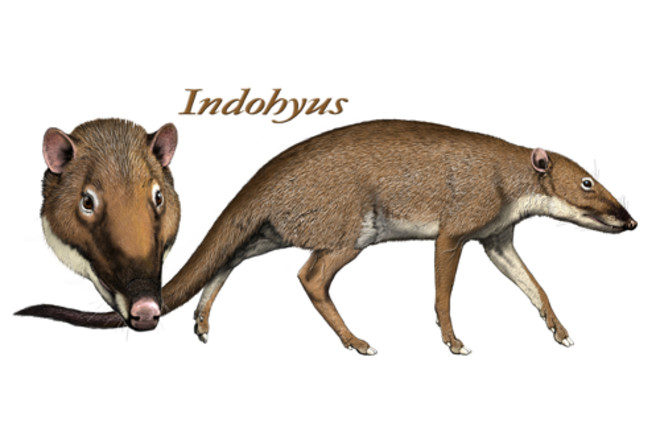
Last week I wrote about a new study that identified a fossil mammal as the closest relative to whales, helping to shed light on how whales moved from land to sea. The mammal, Indohyus, was a small four-legged creature that probably spent a fair amount of time in water and ate vegetation. The authors of the new study proposed that the ancestors of whales originally lived this way. Gradually, the whale lineage became more adapted to life in water and shifted to eating meat, as exemplified by early whales like Ambulocetus, which was something like a furry alligator. In the comment thread, Noumenon asked this question:
I don't understand how Indohyus and Ambulocetus, both dated to around 47 mya, can both be the ancestors of today's whales. You say carnivory was an important transition for whales. Then Indohyus would have had to split off before Pakicetus, before whales became carnivorous.
Via email, I got a similar question from a biologist I know who is working on a book about evolution. He had read about the discovery in this article by Ian Sample in the Guardian, who declared:
Fossil hunters have discovered the remains of the earliest ancestor of the modern whale: a small deer-like animal that waded in lagoons and munched on vegetation.
So how can an ancestor be younger than its descendants? Simple answer: It can't. If you head back to the original paper, you'll see that the scientists compared the skeletons of a lot of living and dead mammals in order to draw a tree. Each species they studied is a twig on that tree. Each twig is linked to other twigs through a shared ancestry. But the scientists did not line up species in a chain of ancestors and descendants. It is sometimes possible to find the fossil of one extinct species that evolved into another extinct species. But if scientists only studied evolution that way, they'd be ignoring a wealth of other clues to how evolution unfolded. As a lineage of mammals evolves, it acquires traits that will set all its subsequent members apart from other mammals. Roughly 150 million years ago our ancestors evolved a placenta. Placentas are found in humans, bats, elephants, whales, and thousands of other species. They are not found in platypus or echidnas. Platypus and echnidnas, thanks to their position on neighboring branches in the tree of life, tell us something about our ancestry. Like them, our own ancestors once lacked a placenta. That does not mean, however, that echidnas or platypuses are our ancestors. By using these methods, scientists can look to Indohyus and get some ideas about what the ancestors of whales were like, even if Indohyus lived after the oldest known whales. Indohyus is the closest relative to the group of mammals called cetaceans. Only after it branched off did cetaceans gradually become more like the whales around us today. I've put together a simple tree showing how those traits appear to have evolved in early whales, based on what scientists know about fossil whales and how they're related. You can find it at the end of the post. Of course, this is a scientific hypothesis that needs to be tested. And the way to test it is to find more species like Indohyus. If paleontologists are lucky, they'll be able to draw more branches at the base of the whale tree. And if the current hypothesis is right, a lot of the species belonging to those deep lineages will be a lot like Indohyus. They may turn out to have lived before the oldest whales, or they may have lived millions of years later. But that's not the heart of the matter. What matters is kinship. In the annals of misleading science reporting, this may be pretty small potatoes. But mistaking relatives for ancestors does lead to confusion, and it gets in the way of appreciating some very elegant research. And, of course, some people pretend that the fact that relatives are not direct ancestors means that evolution is false. So it's worth getting right--not just for whales, but for humans, flowers, or any other organism. [Update Thursday--8:30 am: changed "kangaroos" to "echidnas." Thanks to Alan for pointing out that kangaroos have (primitive) placentas.]



